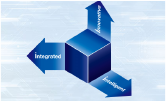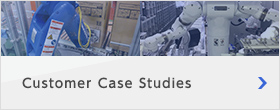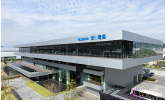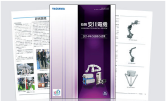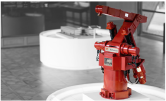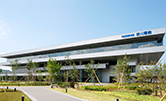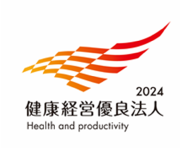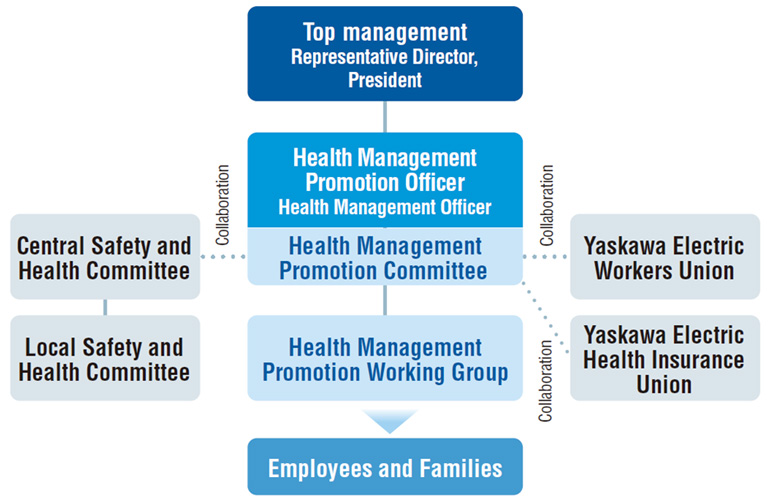Realization of a comfortable working environment
As economic conditions and society change, it is essential for a company’s mid- to long-term growth that each and every one of its diverse employees fully demonstrates his or her abilities. To this end, we are working to change our work style to one that is productive and dynamic, and to create a work environment in which employees can work with peace of mind by managing the balance between work and private life.
Realization of diverse working styles
We introduced a telework system to create an environment in which productivity and results can be achieved regardless of time or place. Through the use of ICT, we have introduced a tool for managers and employees to confirm and communicate their daily work plans and performance remotely and have developed a system that enables fair evaluation.
In addition, in order to encourage the participation of a diverse range of human resources, we reexamined the manner in which employees are transferred and introduced an area-limit system that allows employees to choose their work location according to their life events, regardless of the reason, and that does not involve changes in treatment.
Moreover, we will improve work-life management by encouraging men to take child-care leave, thereby improving productivity and job satisfaction. The ratio of men taking child-care leave was 56% in FY2023.
Expansion of Support System for Balancing Childcare and Nursing Care
Platinum Kurumin
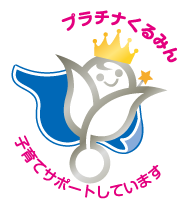
In fiscal 2017, we introduced a system that allows employees to take accumulated leave on an hourly basis, work at home, and take a leave due to their spouses’ overseas transfer. We are increasing the number of work options to support a balance between childcare and nursing care and work. With regard to childcare in particular, since fiscal 2018, we have been receiving a “Platinum Kurumin Certification” from the Minister of Health, Labor and Welfare, in recognition of the introduction and increased use of systems that support balancing work and family, as well as our high standards of measures.
In April 2021, we introduced a new telework system, replacing the existing work-from-home system, which has limits on the number of days and reasons, with the aim of establishing an environment in which employees can work flexibly, regardless of location or time, and achieve results by increasing productivity. By using the telework system, many employees who need to balance work with childcare, nursing care, and medical treatment can work continuously.
Childcare and nursing care support system
Below is a part of Yaskawa’s childcare and nursing support system.
| Shorter working hours |
Employees with childcare and nursing care responsibilities can shorten working hours to six
hours a day. *In the case of childcare, applicable until the child graduates from elementary
school
|
| Spouse childbirth leave (paid leave) |
Five days of leave can be taken within eight weeks before and after the due date. *Leave can
be split.
|
| Childbirth leave for fathers |
Leave given to fathers for up to four weeks within eight weeks of the childbirth. *The leave can be split
|
| Accumulated leave (paid leave) |
Accumulated leave of three days a year are granted from the second year of working at Yaskawa.
Accumulated leave can be held for up to 30 days and can be used for childcare, PTA activities,
nursing care, etc. and can be taken on a daily, half-day, or hourly basis. |
| Telework |
In addition to work-from-home, the system enables working at in-house satellite offices or
mobile working, and there is no upper limit on the number of days or hours the employees can
use if approved by their supervisor.
|
Support for balancing work and treatment
Balancing support coordinator
Yaskawa has appointed a Balancing Support Coordinator since 2018 to enable employees who are sick but have the motivation and ability to work to continue to work vigorously while receiving appropriate medical treatment, free from anxiety.
Other Support
Accumulated leave
Accumulated leave can be used not only for childcare or nursing care but also for self-treatment, volunteer activities and self-development. In recent years, natural disasters have increased, and many employees have taken advantage of the accumulated leave to participate in volunteer disaster recovery activities.
Flextime system
The flextime system allows employees to allocate work and private time according to their daily convenience, and to decide when to come in and leave work within the total working hours for a period of one month. In addition to utilizing childcare, nursing care and personal development, the system aims to enhance the fulfillment by working in a flexible manner.
Efforts to promote the acquisition of annual paid leave
As part of its efforts to create a company that is rewarding to work, Yaskawa encourages employees to take five consecutive days off a year, and many employees take advantage of this system. Through these efforts, we aim not only to take time off to improve our work-life management, but also to create a workplace environment that is free from unreasonableness and waste.
Creating a Safe and Healthy Work Environment
Yaskawa Group Health Management Declaration has been widely declared both inside and outside the company, and health management is promoted under the leadership of the Health Management Promotion Committee. In March 2024, the Group was certified as a “Excellent Corporations for Health Management 2024”. We aim for sustainable growth and development of the company and its employees by improving productivity by creating an environment in which each employee can work with peace of mind and demonstrate their full potential.
Health Management Declaration
In order to realize Yaskawa Principles, “contributing to the development of society and the welfare of mankind through the execution of its business,” the Yaskawa group aims to maintain healthy, safe, positive and rewarding workplace by supporting the development of health as a base for the job satisfaction of each employee.
- We eliminate diseases and injuries caused by working in the company.
- We increase the number of employees who practice health and safety activities autonomously.
- Each employee aims to create a safe, positive, and rewarding work environment and work style.
March 1, 2023
Masahiro Ogawa
Representative Director, President
YASKAWA Electric Corporation
Health management promotion system
In accordance with the Health Management Declaration established under the responsibility of the Representative Director, President, the director in charge of health management shall be responsible for the promotion system.
In order to promote health management, the Health Management Promotion Committee, chaired by the director in charge of health management, shall be held at least twice a year to improve productivity by creating an environment in which each employee can work with peace of mind and maximize his/her abilities, with the aim of achieving sustainable growth and development of the company and its employees.
The members of the Committee are cross-functional, including union members.
The division in charge of health management cooperates with professionals such as occupational physicians and occupational health staff, as well as with health insurance unions, and is working to resolve issues to achieve goals across the organization.
Health Issues and Specific Initiatives
Since fiscal 2023, we have been working to improve the following items.
| Desired outcomes |
Items |
1. Eliminating diseases and injuries caused by working in the company
(Duty of safety consideration: Company) |
Frequency of lost time injuries |
| General regular health screening rate |
| Rate of stress check examination |
2. Increasing the number of employees who practice health and safety activities autonomously
(Self-health duty: Employee) |
Smoking rate |
| Proper weight maintenance rate |
| Rate of exercise habit |
| Good sleep ratio |
| Drinking habit ratio |
3. Each employee aims to create a safe, positive, and rewarding work environment and work style.
(Job satisfaction/engagement: Employee and company) |
Work engagement |
| Degree of vigorousness (presenteeism) |
We have created a strategic map that shows the link between concrete efforts to solve health problems (health investment) and improvements in the final indicator targets and are working on these initiatives.
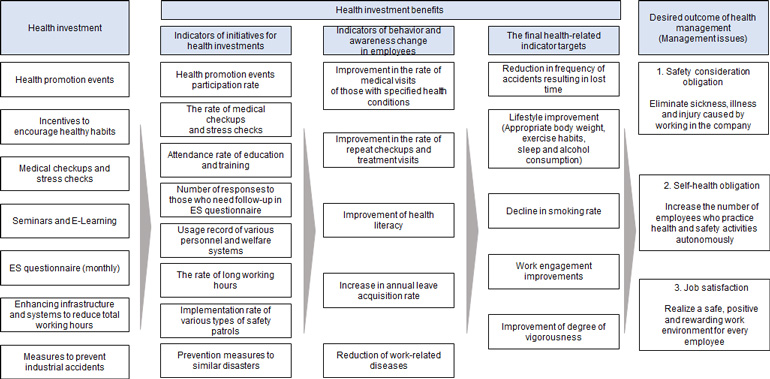
Occupational safety & health
Based on the “Yaskawa Group Code of Conduct”, we ensure the safety and health of the workplace, and comply with laws and internal rules regarding workplace safety.
In addition, we have established a system for labor and management to manage occupational safety and health, and are working to maintain a safe and healthy working environment.
Occupational Health and Safety Promotion System
Yaskawa has appointed a company-wide general safety and health manager to oversee safety and health activities, and the Central Safety and Health Committee meets twice a year. The Committee consists of an equal number of members from labor and management, and representatives from each business site and group companies participate as observers. Based on the policies determined by the Central Safety and Health Committee, each business site and Group company determines, manages, and operates its own policies in the monthly Safety and Health Committee meetings. Specifically, they include the dissemination of disaster cases and their countermeasures, the confirmation of matters pointed out by patrols and the contents of improvements, the reporting of near-miss incidents, and measures against long working hours as well as the implementation of e-learning on health promotion to improve health literacy.
Number of Employees who Participated in Health and Safety Training
We conducted the training programs below in fiscal 2023.
| Training |
Method |
No. of Participants |
| Safety and health education for new employees |
Collective training |
139 |
| Mandatory safety education |
E-learning |
497 |
| Health promotion education |
E-learning |
2,770 |
| Mental health self-care education |
E-learning |
2,869 |
Occupational Health and Safety
Based on the concept of an occupational health and safety management system, each workplace prepares work standards and conducts education and training, risk assessment, and accident prevention activities in daily work. We also conduct internal audits to ensure that these activities lead to the achievement of our health and safety policies and targets, and provide thorough guidance on the items pointed out by the health and safety committees at each business site to make further improvements. As a result, the lost time injury frequency rate (LTIFR) in Yaskawa Electric and its domestic group companies have remained below the average for the same industry.
In FY2023, the LTIFR was 0.16 for Yaskawa Electric, 0.44 for the Yaskawa Group in Japan, and 0.56 for the Yaskawa Group overseas*. All three figures were worse than the previous year. Most of these injuries were caused by falls outside the workplace. In addition to thorough preventive measures and safety patrols, we are taking measures such as walking and other health events.
* LTIFR of three factories in China (Shenyang, Changzhou and Shanghai) and Yaskawa India
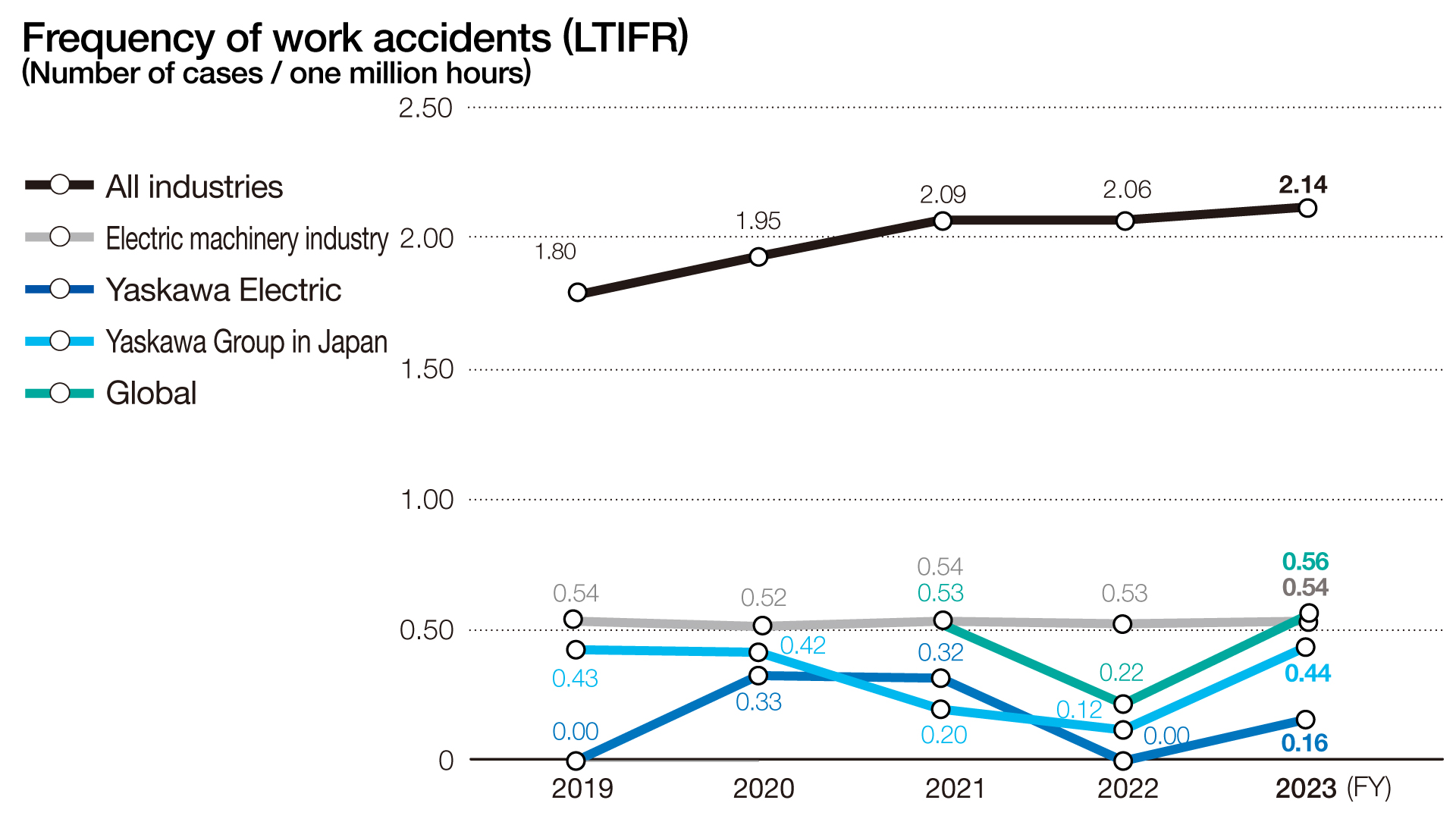
*LTIFR: Indicates the frequency of occurrence of accidents by the number of casualties due to industrial accidents per one million gross hours of actual work.
Calculation method: (Number of casualties due to industrial accidents/gross hours of actual work) × 1,000,000
Implementation of occupational health and safety measures
In fiscal 2023, we continued to implement the following measures for occupational health and safety.
・By carrying out regular patrols by industrial physicians and health managers, we are working to raise the awareness of safety among those who point out and those who are inspected.
・We are working to ensure that employees submit near misses.
・We conduct safety patrols at our plants and offices in order to enhance inspection based on expert knowledge.
・The following safety and health education programs are implemented.
Training are provided at the time of employment, when work contents are changed, when work standards are established or changed.
Safety and health education for employees within three years of employment
Safety and health education for employees handling specified chemical substances
Special education for workers engaged in dangerous or harmful work
Education corresponding to workplace accident trends
Employee Health Support
With regard to various medical examinations, we take into full consideration the related laws and characteristics of examinations, and strive to implement them organically and efficiently, from grasping the working environment and selecting the subjects, to conducting the examinations and taking follow-up measures. We provide health guidance and education focusing on lifestyle and employment support as well as prevention of work-related illness.
Mental Health Measures
We consider psychiatric disorders and disabilities, as well as other diseases, to be diseases that can occur to anyone, and provide support in terms of daily life and work as necessary.
As part of measures to deal with psychological stress, which has various effects on employees’ health and lives, we use a stress check system and provide feedback to individuals and the workplace based on the results.
For external mental health consultations, we have expanded our consultation desks to cover 24 hours a day, 365 days a year, including holidays.
Support for People on Sick Leave to Return to the Workplace
When employees return to their workplace after taking long leave due to inevitable sickness or injuries, we prepare the maximum possible physical support structure and physical environment to support them in collaboration with the individuals, as well as their superiors, the administration department, and the industrial doctor.
 Region
Region



 Principles & vision
Principles & vision
 Procurement
Procurement
 Sustainability for the Yaskawa Group
Sustainability for the Yaskawa Group
 Customer satisfaction
Customer satisfaction
 Supply chain
Supply chain
 Social contribution
Social contribution
 Compliance & risk management
Compliance & risk management



